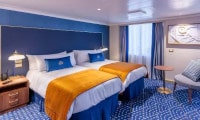




Itinerary

Day 1 : London/ENGLAND

Day 2 : At Sea

Day 3 : Hamburg/GERMANY
Hamburg's port on the river Elbe has been busy since medieval times, when it was a cornerstone of the Hanseatic League. It is a graceful city of parks and lakes, and grand old buildings like the Rathaus (City Hall). Brahms and Mendelssohn were born here, and Hans Leip, who wrote Lili Marlene.

Day 4 : At Sea

Day 5 : Copenhagen/DENMARK
The European culture capital in 1996, Copenhagen is Scandinavia's liveliest city. The musical and artistic pageantry are rivaled only by the changing of the guard ceremony in front of the Amalienborg Palace, home of the royal family since 1794. Yet certain parts of Copenhagen maintain a village-like feel, like the winding streets around the Raadhuspladsen and enchanting Tivoli Gardens.

Day 6 : At Sea
Day 7 : Visby/SWEDEN
Situated on the Swedish isle of Gotland, Hanseatic Visby was one of the most powerful cities in Europe. Today quaint homes and churches huddle together inside 13th-century walls. In former times, it was called "the city of ruins and roses," for along with its rose-covered churches, there is one somber sight - Gallows Hill, a place of execution so villains "might die looking at the loveliest spot on earth."

Day 8 : Tallinn/ESTONIA
Tallinn is the capital of the recently independent republic of Estonia. In the medieval old town, with its winding cobbled streets, there is a marvelous cathedral and Gothic town hall dating from the 14th Century.

Day 9 : Helsinki/FINLAND
Finland's national capital is a spacious Neoclassical city in fine white granite, whose upbeat pace and fashion sense belie the Finnish reputation for conservatism. The massive Temppeliaukio Church is carved out of solid stone, while on the Esplanadi, famous Finnish designers like Marimekko or Iitala demonstrate a lighter, more modern style.

Day 10 : At Sea

Day 11 : Arhus/DENMARK

Day 12 : At Sea

Day 13 : Hamburg/GERMANY
Hamburg's port on the river Elbe has been busy since medieval times, when it was a cornerstone of the Hanseatic League. It is a graceful city of parks and lakes, and grand old buildings like the Rathaus (City Hall). Brahms and Mendelssohn were born here, and Hans Leip, who wrote Lili Marlene.

Day 14 : At Sea

Day 15 : London/ENGLAND
